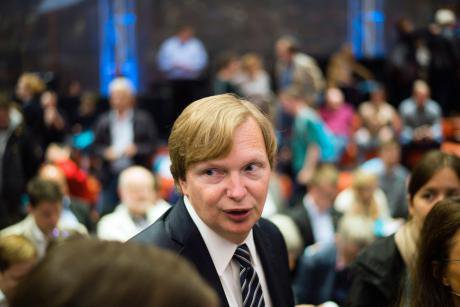
Jim Messina in 2015. Gregor Fischer/PA Images. All rights reserved. Many were shocked that right-wing causes such as those associated with the Brexit referendum and the election of Donald Trump could garner decisive support via social media. These campaigns mobilised memes and fake news bots, but also highly sophisticated targeted advertising based on data analytics, to brainwash and manipulate voting populations – or so the argument goes.
We need an appreciation of the ‘libidinal’ nature of politics online.
While many moderate liberals have responded to this with an increased suspicion of social media and new technologies, we argue that the left needs not to resist algorithms, but to create new algorithms of resistance in place of those being used by the corporate state and those on the right. To do this it needs an appreciation of what we call the ‘libidinal’ nature of politics online. The surprise result of the 2017 General Election in the UK has shown that digital media can be just as congenial to left-wing causes as it has been to right-wing ones over the past few years, but in order to put this potential to use we need a better understanding of how such processes work. This needs to start with the revision of a number of assumptions about how social media affects people in the way it does.
Normies, sheeple and political agency
The similarities between the Trump presidential run and the ‘Leave’ campaigns in the UK referendum were not coincidental. Leave.EU, the rowdier unofficial ‘second’ Eurosceptic campaign, headed by Nigel Farage, had its communications director, Andy Wigmore, meet with Trump’s advisors in summer of 2015. Together, they discussed political style, in particular how Leave.EU could imitate the ‘gaming’ of media cycles achieved by Trump’s deliberately outrageous remarks. Both campaigns kept their messages in the news by presenting themselves as offensively as possible, and then ‘doubling down’ when apologies were demanded, ensuring they were repeated in the news and on social media over and over again.
Subsequently, both campaigns recruited Cambridge Analytica, a company which promised to revolutionise political campaigning. Political parties have been using expressions of political opinion by people on social media as a campaign tool since at least the Obama campaign of 2008. But Cambridge Analytica claimed to be able to take this a stage further. Using a method called ‘psychometrics’, the company inferred from ‘likes’ on Facebook, not just political allegiances, but specific personality types and emotional states, and then algorithmically directed tailored political content to their newsfeeds. This enabled them to reach the voters they anticipated would be most susceptible to their clients’ ideologies. As one account of the method puts it, “psychological profiles [can] be created from your data, but your data can also be used the other way round to search for specific profiles: all anxious fathers, all angry introverts, for example—or maybe even all undecided Democrats?”.
It is not clear quite how much Cambridge Analytica helped either Trump or ‘Leave’, and the likelihood is that this has been overstated. Both campaigns have been unforthcoming in acknowledging the company’s help, and it may also suit the company itself to appear as a shadowy operator, capable of delivering the impossible.
What is clear, however, is that stories about Cambridge Analytica have fuelled what many people seem to want to believe about social media: that it is turning us into uncritical zombies, reducing everything to the lowest common denominator, and brainwashing ‘the masses’, who are – anyway – always only a few steps away from outright barbarism.
Stories about Cambridge Analytica have fuelled what many people want to believe about social media: that it is brainwashing ‘the masses’, who are – anyway – always only a few steps away from outright barbarism.
But the left is already using forms of digital media to gain support online. Our contention is that they will only be successful if it is able to move away from the view of ‘the masses’ implied in liberal criticisms of the Trump and ‘Leave’ campaigns as prone to confusion – ‘they know not what they do’. Instead, we must recognise that social media users are now active political participants – not just a mass to be manipulated – and focus on how to understand and engage these users more accurately.
Fear of how easily ‘the masses’ might be manipulated stems from a very old conservative mythology, one that has a particularly vibrant life in the alt-right’s resentment-fuelled dismissals of ‘normies’ and ‘sheeple’. The left and liberal centre is not immune to this thinking either: witness how swiftly some leftists dismiss consumers of Fox News or Britain’s Sun newspaper as simply stupid, or how some liberals speak of any group expression of political allegiance to the left of them as if it were a cult. In a useful corrective, the literary critic Raymond Williams once remarked that “there are no masses, only ways of seeing people as masses”. The left cannot win if it makes the mistake of copying the right’s belief in brainwashed ‘sheeple’ when talking about those who disagree with them.
This is not, however, quite the same as thinking that people are just free agents, and are immune to being influenced online. Success on digital platforms comes not from unscrupulously exploiting ‘sheeple’ by lying to them, or by manipulating the emotional vulnerabilities they may reveal in their online behaviour. Instead, political success online comes from realising that digital media thrive on what psychoanalysts call ‘libido’. While modern media have always worked by trying to trigger and direct our desires, online media depend on them in new and material ways.
Digital media’s ‘libidinal’ economy
Both older forms of data-based advertising and traditional political polling asked the voter the question ‘what do you want?’, without sufficiently attending to the complexity of the question. According to psychoanalytic theories, the question of what we want is always bound up in the construction of desires through politics, and culture, and technology. This new terrain can’t, then, be negotiated without psychoanalysis.
The literary critic Raymond Williams once remarked that “there are no masses, only ways of seeing people as masses”.
In his essay ‘Suggestion and Libido’, Freud discussed the relationship between individual and group desires. Using the concept of ‘libido’ to throw light on group psychology, Freud argues that a particular form of pleasure is found, not in pursuing individual desires, but in giving up what the individual wants for what the group wants. This is far from the simple utilitarian argument that we must give up what we want for a greater good. Rather, it acknowledges that a new type of pleasure and desire becomes possible in the act of desiring with a group. The contemporary right makes use of this form of political pleasure often. Trump’s campaign was full of such creations of a ‘desire of the Other’. Chanting ‘build the wall’ or ‘lock her up’, was as much about the pleasure of joining in with a desire so passionately enjoyed by others, as it was about any personally held policy conviction. The alt-right constitutes another specifically digital example, where pleasure is particularly found in grouping towards a political outcome.
While left-alternatives like 8Chan’s /leftypol/ board and Bunkerchan have emerged, the left has often been behind the right when it comes to putting this desire to work, not least because the right’s cravings often seem unpalatably close to fascism, taking forms the left has seemed reticent to ape. But a movement from individual to group desire need not remain the preserve of the right: there is no reason that the left cannot harness digital media platforms and use group desire to assert a left agenda.
The causes that stand to benefit most from digital media are not determined by the terms ‘left’ and ‘right,’ nor by ‘honest’ and ‘fake’’. They are determined by how much they manage to solicit users’ desires. Political success online is dependent on two interrelated ingredients: data and shareability. Campaigns need a stockpile of contact information, records of prospective supporters’ online behaviour, and innovative ways of interpreting them. Then, their material needs to lend itself to being shared beyond initial users, validated by the fact that ‘ordinary people’, are sharing it.
But only certain kinds of politics are alluring enough to provoke the casual online behaviour that allows campaigns to know where to direct their arguments. Digital media is a media of desire, and will always reward the political campaign with the most claim on ‘the libidinal’: in particular, campaigns have most to offer in terms of the collective pleasures described above. This is why the attempts of Activate – the Tory youth group – to emulate the success of the left’s Momentum was doomed to fail, even before they collapsed after a couple of weeks of infighting and scandal: digital-libidinal politics is not some pre-existing model that can be applied to any position or cause.
From Brexit to Corbyn
In the UK’s EU Referendum, ‘Remain’ and ‘Leave’ used digital media to infer voter’s likely political allegiances from their behaviour on social media, and used this information to inform targeting of social media advertising, to create mailing lists, and even to direct on-the-ground contact with campaigners. A version of this strategy had been employed in Obama’s re-election campaign in 2012 run by Jim Messina, who was recruited by the Conservatives for the 2015 General Election. In that election, activists reported that Messina’s model was especially effective in surreptitiously recruiting voters who – the model predicted – could be convinced to vote Conservative, without rival parties in the constituency even being aware that targeting was going on.
In the relatively mainstream electoral contexts of Obama’s re-election and the 2015 UK election, Messina’s model worked well, but it came under some strain in the EU referendum. The most straightforward reason for this failure is the fact that the model was designed to target extremely specific groupings of undecided swing voters in specific decisive parts of the country – much fewer in a General Election than in a referendum. Messina complained that by the time the data that was needed to make adequate inferences about groups’ motivations was finally sourced, the campaign's spending limit (a restriction on what the campaigns were permitted to spend) had already set in. This delay in finding adequate data meant that Remain was limited in what it could do with it when it was finally found.
More significantly, the Leave campaigns could draw on years of data trails, networks, and online interactions occurring in the orbit of the Eurosceptic party, UKIP. This was material people had long been sharing online. Allegiance to the EU, by contrast, had historically created no such ‘libidinal institutions’; nothing like the culture of Facebook groups, shareable memes, and ‘likeable’ Facebook pages that are necessary producing hordes of data. Digital media, in this case, was necessarily on the side of whichever politics was best suited to creating these stores, material that people took pleasure in spontaneously sharing. It was not a question of which side was most willing to lie and brainwash people, but of which side tapped into these libidinal behaviours.
Against expectations, these same ‘libidinal’ patterns served the left spectacularly in 2017. After Leave’s successful use of lurid ads about the risks of remaining in the EU, the Conservative Party, under Messina’s guidance, spent millions on Facebook advertising focussed on Jeremy Corbyn’s alleged terrorist sympathies and Labour’s economic irresponsibility. The Labour left campaiging group, Momentum, meanwhile, was criticised for its irreverent memes, and videos satirising Tories, and was accused of ‘preaching to the converted’ with short clips of Corbyn’s rallies (the same criticism continued to be made after the election about Corbyn’s appearance at Glasonbury). At the same time, Momentum created a ‘My Nearest Marginal’ app, allowing Corbyn supporters to bypass local parties and simply turn up to campaign in the places it would make the most difference. The Labour Party itself adopted another Momentum innovation – the Labour phone app, which allowed any party member to talk to undecided voters in their own time, and from their own homes.
A digital libidinal left
Stunningly, Momentum’s digital strategy was vindicated. While no pro-Conservative election material ‘went viral’ during the campaign, Momentum’s did regularly, because it was funny, and created collective pleasure. Indeed, backing Corbyn online became its own pleasure, as it meant being welcomed into a culture of irreverent memes calling him ‘the absolute boy’. The apps were also a ‘libidinal’ pleasure to use, because in contrast to the self-sacrificing and technocratically controlled atmosphere of traditional Labour campaigning, this was to be done on your own time, with your own friends, with technology that was second nature.
All these examples of left technology involve empowering users, rather than conceiving of the target user as passive and susceptible to manipulation.
The broader left’s realisation that appealing to ‘the people’ now means appealing digitally to people’s desires – in all their complexity – can be witnessed in various examples of emerging left technology. The New Inquiry’s ‘White Collar Crime Risk Zones’ application, for example, uses industry-standard machine learning to predict where financial crimes will happen across the US, combatting the right-wing trend (and policing algorithms) which associate crime statistics with impoverished and non-white communities, instead showing a link between wealth and criminality. Similarly, The Southern Poverty Law Center has created a ‘hate group tracking map’ identifying fascist and racist organizations in the US and allowing users to follow their movements and organise resistance. In each case, the technology enables users to enjoy taking an active role in its potential uses.
Left-wing ‘memeing’ is another example of people putting themselves to work in the service of a political movement, extricating memes from their apparently apolitical history and seeing them as important political tools. The many programmes created by the hacktivist Aaron Swartz (except perhaps Reddit), form trailblazing parts of this evolving culture. Among other things, Swartz was responsible for campaigns for net neutrality, online petitioning and lobbying sites, as well as the creation of the Creative Commons, before his premature death under pressure from a US government determined to make an example of him. Recently, Evgeny Morozov and Nick Srnicek have made crucial appeals to the left to become more involved in imagining alternative ownership models for online platforms like Google and Facebook, that could wrest these essential tools of daily life from the self-interested and secretive bodies that currently control them.
All these examples of left technology involve empowering users as active participants and investigators, asking them to search, share and create online ‘content’, rather than conceiving of the target user as passive and susceptible to manipulation. Such technologies recognise users as libidinally motivated actors, not as brain-washable sheeple. If social media users were not ‘sheeple’ when they were enthused by Corbyn online, neither were they ‘sheeple’ when they were won over by Leave or Trump. A tech-savvy left will win again by continuing to develop innovative digital media for campaigning: but it also needs to commit to a left-‘libidinal’ understanding of what audiences are when they use digital media, what convinces them online and provokes them into action. While traditional politics has claimed to keep itself apart from pleasure and desire, if the left is to succeed at this juncture, it must recognise not only that desire is influenced by politics, as psychoanalysts have long argued, but that politics must sometimes be influenced by desire.
Read more
Get our weekly email





Comments
We encourage anyone to comment, please consult the oD commenting guidelines if you have any questions.